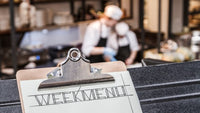- Finance
-
Shop Used Equipment
- Beverage
- Coffee
-
Cooking
- Shop all cooking
- Bratt pans
- Char grills
- Chicken rotisseries
- Combi ovens
- Contact grills
- Convection ovens
- Conveyor toasters
- Conveyor, deck and pizza ovens
- Cooktops
- Cooktop oven combos
- Crepe and pancake makers
- Fryers and oil filters
- Griddles
- Microwaves
- Pasta cookers
- Range ovens
- Rice cookers
- Salamander grills
- Sous vide
- Tandoor ovens
- Toaster Grills
- Vertical broilers
- Waffle and crepe makers
- Wok burners
- Other cooking equipment
- Dishwashers
- Food display
-
Food preparation
- Shop all food preparation
- Blenders
- Dough rollers and sheeters
- Food processors
- Fruit and veg prep
- Ice-cream machines
- Juicers
- Mixers
- Pizza prep tables
- Proofing and warming cabinets
- Sandwich and salad prep tables
- Slicers and grinders
- Sushi makers
- Vacuum packaging machines
- Other food preparation equipment
- Point of sale
-
Refrigeration
- Shop all refrigeration
- Back bar coolers and kegerators
- Blast chillers/freezers
- Chef bases
- Chest freezers
- Countertop fridges
- Display freezers
- Display fridges
- Gelato freezers
- Ice-cream machines
- Ice machines and bins
- Pizza prep tables
- Reach-in freezers
- Reach-in refrigerators
- Sandwich and salad prep tables
- Slushy machines
- Under counter freezers
- Under counter fridges
- Other refrigeration equipment
- Restaurant furniture
- Stainless steel
- End of Season Sale
- Shop all equipment
- Customers
- FAQs
- Resources
- About Us
Share
Six features of the best restaurant menu designs
article
Clarity
Perhaps one of the most important aspects of menu design is clarity. If your customers have a hard time reading the menu, their experience starts to diminish rapidly. Nobody wants to have to pull out their reading glasses or squint under mood lighting to read your menu. Make sure it's professional, but legible.
Price Range
It's good to have a wide range of prices. Obviously, fancier restaurants won't necessarily have a dollar menu. However, within the range that's appropriate for your dining establishment, there should be a reasonable range in price. Additionally, it's good to cater to those who are less hungry and those who are starving. Having a variety in plate size can help you create a wider range of prices.
Cleanliness
The menu itself should be presentable and clean at all times. It's very unappetizing to look at a menu that has smudges, smears, or dirty spots. Try to clean your menus after every customer. This also aids in overall sanitation of your restaurant.
Structure
How you structure the items on your menu is important. It doesn't have to be laid out in any particular order, it just has to be logical and organised. Having items listed in a long list with no categories, for instance, can be overwhelming. Myth has it that customers scan a menu starting in the upper right-hand corner, and convention used to say that placing your higher-priced items there is beneficial. However, new research has shown that customers read menus much like a book, so don't worry about 'hot spots'. Just make it organised and easy for your customers to find what they need.
Currency Signs
Another interesting characteristic all best restaurant menu designs have in common is that they don't emphasise the currency sign. In other words, if your dollar signs are large, you should probably change that. Research has shown that emphasising the currency sign makes people feel as though they're paying more, even if that's not the case. Some of the most effective menus don't have currency signs at all, they just write the price out numerically (i.e. 3.00 or simply 3).
Photography
Use photography minimally, if at all. While you might think photos of your offerings will help sell, it's not effective. Psychologically, people associate large photos with chain restaurants, fast food, and advertisements. They're more attracted to a listed menu with little to no photography. If you feel photography is important, consider illustrations instead as they can better convey the mood of your establishment without running the risk of sending the wrong message.
These are just a few of the things you should consider when creating a menu. Creating an amazing menu that engages and informs your guests can help establish clientele that keeps coming back. Have a few people who aren't associated with your restaurant view your menu and give you feedback. You might be surprised what you could learn.
